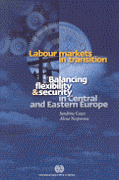“The debate on labour market flexibility is very lively and there is a large and growing literature on the subject. The novelty of this book is that it includes comparative studies of labour market flexibility from a wide range of transition countries, thus giving a depth and perspective rarely found in a single volume. Of interest to economists and social scientists from many disciplines, and from advanced undergraduate to research level, this volume will also be of considerable value to policymakers and governmental agencies.”—Raul Eamets, vice-dean and associate professor, Faculty of Economics and Business Administration, University of Tartu, Estonia
The economic and structural changes in the transition countries since the break up of the Soviet Union have been unique and profound. This book explores how the labor markets of the Central and Eastern European transition countries, the Baltic States, and the Russian Federation have developed in response to this and to the new challenge of accession to the European Union.
Through cross-country analysis, the volume examines the sectoral structure of employment as well as the changes in its major characteristics, such as employment status, type of labour contract, formal/informal employment and others. The strictness of employment protection legislation is also explored, and this study evaluates its effect on the level and structure of employment and unemployment both for selected transition countries and Western industrialized countries. In addition, the developments in labour market institutions, labour market policies, collective bargaining and labour taxation in ten transition countries are compared with selected OECD countries presending a clear, overall policy picture.
The book offers convincing policy recommendations for the better management of labour market changes from an economic and social point of view, while keeping in mind the overarching long-term goal of achieving full, productive and fully chosen employment at the global, regional, national and local levels.
Authors
